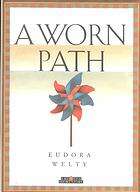A Worn Path
| "A Worn Path" | |
|---|---|
 | |
| Author | Eudora Welty |
| Country | USA |
| Language | English |
| Published in | Atlantic Monthly, vol. 167, no. 2[1] |
| Publication type | Magazine |
| Media type | Short story |
| Publication date | February 1941 |
"A Worn Path" by Eudora Welty is a short story about an elderly African-American woman who undertakes a familiar journey on a road in a rural area to acquire medicine for her grandson. She expresses herself, both to her surroundings and in short spurts of spoken monologue, warning away animals and expressing the pain she feels in her weary bones. This shows that "A Worn Path" is a tale of undying love and devotion that pushes us toward a goal.
Plot
In "A Worn Path", an old woman named Phoenix Jackson is walking through the woods into town.[2] On her way she encounters many obstacles, including thorny bushes, barbed wire, and a large dog, among others. She meets a hunter, pocketing a nickel that he drops, and a lady who ties her shoes. Her reason for going to Natchez is to pick up a supply of medicine for her grandson, who accidentally swallowed lye a few years before. She tells the nurse in the hospital that the damage to his throat never fully heals, and every so often his throat will begin to swell shut. It is Old Phoenix's love for her grandson that causes her to face the trial of the journey to town, every time it is necessary, with no questions asked.
Obstacles faced by Phoenix:
- Dense forest and wild animals
- Walking over hills
- Thorny bushes
- Crossing small creek on log
- Barbed wire fence
- Cotton field
- Scarecrow in corn field
- Black large dog
- Falling in ditch
- The hunter
- Confusion at city roads
- Stairs at the clinic
Author
The story the Worn Path was written by author Eudora Welty. Welty was born in Jackson Mississippi in 1909. She was a short story writer who wrote about the American south. She attended college at the Mississippi State College for Women and the transferred to the University of Wisconsin to complete a degree in English Literature. In 1933 she published her first short story called "the Death of a Traveling Salesman". During her life she was awarded the Presidential Medal of Freedom and even won a Pulitzer Prize for her novel The Optimists Daughter in 1973. She had a very successful career in writing and published many books that are still read and well known today. Welty passed away at the age of 92 in her hometown of Jackson Mississippi.
Themes
One of the major themes of the short story is unselfish love. Phoenix Jackson loves her grandson so much that she endures a painful walk to town in order to get the medicine that he needs. The story revolves around compassion and the courage that defies reason, since Phoenix is willing to make the journey to town any time it is needed, despite her own age and waning health. Unwavering love of family and future generations motivated Phoenix and many others to show great strength in the face of adversity.
The short story also discusses racism and the arrogance it breeds by marginalizing other people and being cruel to them. However, another theme of the story is the ability of the human spirit to endure conflict and poor circumstances within nature and society.[3]
Symbolism
Popular with Literature classes, the symbolism in the piece and the lesson(s) to be learned from it are open to interpretation. Many critics have commented on the significance of the main character's name in relation to the mythology phoenix, relating to her indomitable ability to rise again and make her journey.[4][5] Many writers argue that it emphasizes racial and economic inequalities in the Deep South during the Depression.[6][7] It is similar to the story of Odysseus, who faces many trials along his journey.[8] Welty herself has said it is a story about how a writer works.[9]
Critical Thinking
What kind of obstacles did Phoenix overcome while on her journey through the forest? What do they symbolize about Phoenix and her journey?
Did Phoenix daydream any of her journey? If so, when?
What makes Phoenix’s mission to get to town so important?
After reading about “A Worn Path” what kind of assumptions can we make about Phoenix’s past? And why?
Why did the people that Phoenix came in contact with on her journey treat her so poorly?
References
- ↑ "A Worn Path". OCLC Worldcat. Retrieved 15 December 2013.
- ↑ Dazey, Mary Ann (February 1979). "Phoenix Jackson and the Nice Lady: A note on Eudora Welty's "A Worn Path"". American Notes & Queries. 17 (6): 92–93.
- ↑ "A Worn Path Themes - eNotes.com". eNotes. Retrieved 2016-11-01.
- ↑ Piwinski, David J. (Winter 2003). "Mistletoe in Eudora Welty's "A Worn Path"". ANQ. 16 (1): 40–42. doi:10.1080/08957690309598188.
- ↑ Bartel, Roland (Summer 1977). "Life and Death in Eudora Welty's "A Worn Path"". Studies in Short Fiction. 14 (3): 288–290.
- ↑ Sykes, Dennis J. (Spring 1998). "Welty's The Worn Path". Explicator. 56 (3): 151. doi:10.1080/00144949809595296.
- ↑ Moberly, Kevin (December 1, 2005). "Toward the North Star: Eudora Welty's "A Worn Path" and the Slave Narrative Tradition". Mississippi Quarterly. 59 (1/2): 107–127.
- ↑ Feeley, Kathleen (15 October 2001). "Remembering Eudora Welty". America. 185 (11): 13–15.
- ↑ Welty, Eudora (1974). "Is Phoenix Jackson's Grandson Really Dead?". Critical Inquiry. 1 (1): 219–221. doi:10.2307/1342926. JSTOR 1342926.